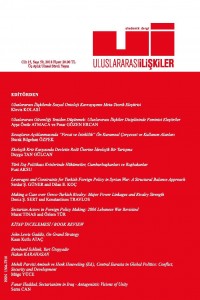Abstract
Bu çalışma, 2006 Lübnan Savaşı’nı tekrardan ele alarak zayıf devletlerde devlet-altı mezhepsel grupların dış politika yapım süreçlerindeki rolünü incelemektedir. Esasen toplumları mezhepsel kimlikler etrafında bölünmüş devletlerde mezhepsel grupların devlet-altı dış politika aktörü olarak nasıl davrandıklarını ve mezhepsel kimliğin zayıf devletlerde aktörlerin kendisini ve diğerini, dolayısıyla dostunu ve düşmanını tanımlamada nasıl rol oynadığını sorgulamaktadır. Böylece bu makale, Lübnan’da Maruni, Sünni, Şii ve Dürzi liderlerin dış politika yönelimlerinin, tercihlerinin ve davranışlarının ortaya çıkışı ve konsolidasyonunu analiz etmektedir. Temel bulgularını Lübnan’da gerçekleştirilen saha çalışması ve liderlerle yapılan mülakatlara dayandıran bu çalışma, zayıf bir devlette bağlayıcı bir dış politika duruşunun yoksunluğunda, mezhebi liderlerin dış politika seçimlerinin anlaşılabilmesinde mezhebi kimliğin, aktörün kendisini ve diğerini tanımlamada merkezi bir rol oynadığını iddia etmektedir.
References
- ........
Abstract
This paper analyses the role of sub-state sectarian actors in foreign policy making in weakly established states by re-visiting the July War of 2006 in Lebanon. It mainly asks how sub-state sectarian actors behave as foreign policy actors in countries where society is divided along sectarian identities and how sectarian identities matter in terms of the definition of the self and the other and the ally and the enemy in weak states. By doing so, the paper analyses the emergence and the consolidation of foreign policy orientations, preferences and behaviour of the Maronite, Sunni, Shi’a and Druze communities in Lebanon, with a specific emphasis on the role of Hezbollah during the war. Building its main findings on various fieldworks in Lebanon, interviewing leaders of major sects; this study concludes that in the absence of a cohesive foreign policy stance in a weak state, the role of sectarian identity in defining self and other becomes central for understanding the foreign policy choices of sectarian actors.
References
- ........
Details
| Primary Language | English |
|---|---|
| Journal Section | Articles |
| Authors | |
| Publication Date | September 1, 2018 |
| Published in Issue | Year 2018 Volume: 15 Issue: 59 |

